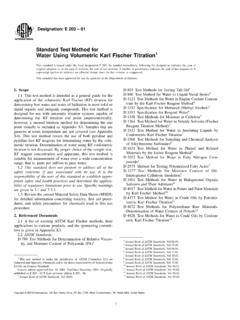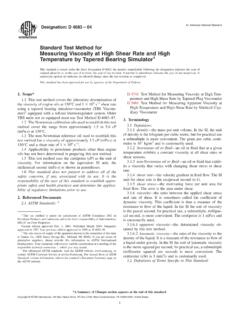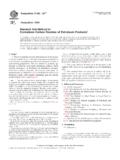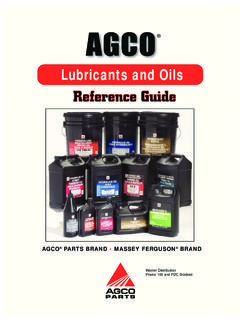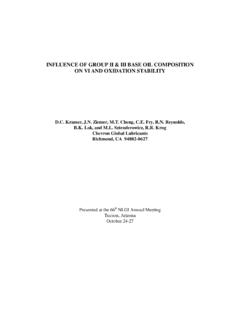Transcription of Standard Test Method for Apparent Viscosity of Engine Oils ...
1 An American National Standard Designation: D 5293 08. Standard Test Method for Apparent Viscosity of Engine Oils and base stocks Between 5 and 35 C Using Cold-Cranking Simulator1. This Standard is issued under the fixed designation D 5293; the number immediately following the designation indicates the year of original adoption or, in the case of revision, the year of last revision. A number in parentheses indicates the year of last reapproval. A. superscript epsilon ( ) indicates an editorial change since the last revision or reapproval. 1. Scope* at Low Temperature Using the Cold-Cranking Simulator3. This test Method covers the laboratory determination of D 4057 Practice for Manual Sampling of Petroleum and Apparent Viscosity of Engine oils and base stocks by cold Petroleum Products cranking simulator (CCS) at temperatures between 5 and ISO Standard : 35 C at shear stresses of approximately 50 000 to 100 000 Pa ISO 17025 General Requirements for the Competence of and shear rates of approximately 105 to 104 s 1 for viscosities Testing and Calibration Laboratories4.
2 Of approximately 900 to 25 000 mPa s. The range of an 3. Terminology instrument is dependent on the instrument model and software version installed. Apparent Cranking Viscosity results by this Definitions: Method are related to Engine -cranking characteristics of Engine Newtonian oil or fluid, n one that exhibits a constant oils. Viscosity at all shear rates. A special procedure is provided for measurement of non-Newtonian oil or fluid, n one that exhibits a highly viscoelastic oils in manual instruments. See Appendix Viscosity that varies with changing shear stress or shear rate. X2. Viscosity , h, n the property of a fluid that determines Procedures are provided for both manual and automated its internal resistance to flow under stress, expressed by: determination of the Apparent Viscosity of Engine oils using the t h5g (1).
3 Cold-cranking simulator. The values stated in SI units are to be regarded as where: Standard . No other units of measurement are included in this t = the stress per unit area, and Standard . g = the rate of shear. This Standard does not purport to address all of the Discussion It is sometimes called the coefficient of safety concerns, if any, associated with its use. It is the dynamic Viscosity . This coefficient is thus a measure of the responsibility of the user of this Standard to establish appro- resistance to flow of the liquid. In the SI, the unit of Viscosity priate safety and health practices and determine the applica- is the pascal-second; for practical use, a submultiple bility of regulatory limitations prior to use.
4 Specific warning (millipascal-second) is more convenient and is customarily statements are given in Section 8. used. The millipascal second is 1 cP (centipoise). 2. Referenced Documents Definitions of Terms Specific to This Standard : Apparent Viscosity , n the Viscosity obtained by use of ASTM Standards:2. this test Method . D 2162 Practice for Basic Calibration of Master Viscom- Discussion Since many Engine oils are non- eters and Viscosity Oil Standards Newtonian at low temperature, Apparent Viscosity can vary D 2602 Test Method for Apparent Viscosity of Engine Oils with shear rate. calibration oils, n oils with known Viscosity and Viscosity /temperature functionality that are used to define the 1.
5 This test Method is under the jurisdiction of ASTM Committee D02 on calibration relationship between Viscosity and cold-cranking Petroleum Products and Lubricants and is the direct responsibility of Subcommittee simulator rotor speed. on Flow Properties. check oil, n a batch of test oil used to monitor Current edition approved Oct. 15, 2008. Published November 2008. Originally approved in 1991. Last previous edition approved in 2004 as D 5293 04. measurement performance. 2. For referenced ASTM standards, visit the ASTM website, , or contact ASTM Customer Service at For Annual Book of ASTM. 3. Standards volume information, refer to the Standard 's Document Summary page on Withdrawn.
6 The last approved version of this historical Standard is referenced the ASTM website. on 4. Available from American National Standards Institute (ANSI), 25 W. 43rd St., 4th Floor, New York, NY 10036, *A Summary of Changes section appears at the end of this Standard . Copyright ASTM International, 100 Barr Harbor Drive, PO Box C700, West Conshohocken, PA 19428-2959, United States. 1. D 5293 08. test oil, n any oil for which the Apparent Viscosity is 6. Apparatus to be determined by use of this test Method . Two types of apparatus are described for use in this test viscoelastic oil, n a non-Newtonian oil or fluid that Method : the manual cold-cranking simulator (see Appendix climbs up the rotor shaft during rotation.)
7 X1) and the automated CCS (see and ). 4. Summary of Test Method Automated CCS,9 consisting of a direct current (dc). electric motor that drives a rotor inside a stator; a rotor speed An electric motor drives a rotor that is closely fitted sensor or tachometer that measures rotor speed; a dc ammeter inside a stator. The space between the rotor and stator is filled and fine current-control adjust dial; a stator temperature control with oil. Test temperature is measured near the stator inner wall system that maintains temperature within C of set point;. and maintained by removing heat with a controlled process to and a heat removal system with a temperature control system, maintain a constant stator temperature during test.
8 The speed of a computer, computer interface, and test sample injection the rotor is calibrated as a function of Viscosity . Test oil pump. Viscosity is determined from this calibration and the measured Automatic Automated CCS,9 as described in with the rotor speed. addition of an automated sample table allowing multiple test 5. Significance and Use samples to be run sequentially under computer control without operator attention. The CCS Apparent Viscosity of automotive Engine oils Calibrated Thermistor,9 sensor for insertion in a well correlates with low temperature Engine cranking. CCS appar- near the inside surface of the stator to indicate the test ent Viscosity is not suitable for predicting low temperature flow temperature.
9 To the Engine oil pump and oil distribution system. Engine There must be good thermal contact between the cranking data were measured by the Coordinating Research temperature sensor and the thermal well in the stator; clean this Council (CRC) L-495 test with reference oils that had viscosi- thermal well periodically and replace the small drop of ties between 600 and 8400 mPa s (cP) at C and between high-silver-containing heat transfer medium. 2000 and 20 000 mPa s (cP) at C. The detailed relation- Heat Removal System: ship between this Engine cranking data and CCS Apparent For stators with coolant contact, a refrigerator for the viscosities is in Appendixes X1 and X2 of the 1967 T edition liquid coolant is needed to maintain coolant temperature at of Test Method D 26026 and CRC Report Because the least 10 C below the test temperature.
10 When the coolant CRC L-49 test is much less precise and standardized than the temperature is below 30 C a two-stage refrigeration system is CCS procedures, CCS Apparent Viscosity need not accurately likely needed. The length of the tubing connections between predict the Engine cranking behavior of an oil in a specific the CCS and the refrigerator should be as short as possible (less Engine . However, the correlation of CCS Apparent Viscosity than 1 m) and well insulated. with average CRC L-49 Engine cranking results is satisfactory. Coolant, Dry Methanol If contaminated with wa- The correlation between CCS and Apparent Viscosity ter from operating under high humidity conditions, replace it and Engine cranking was confirmed at temperatures between 1.
